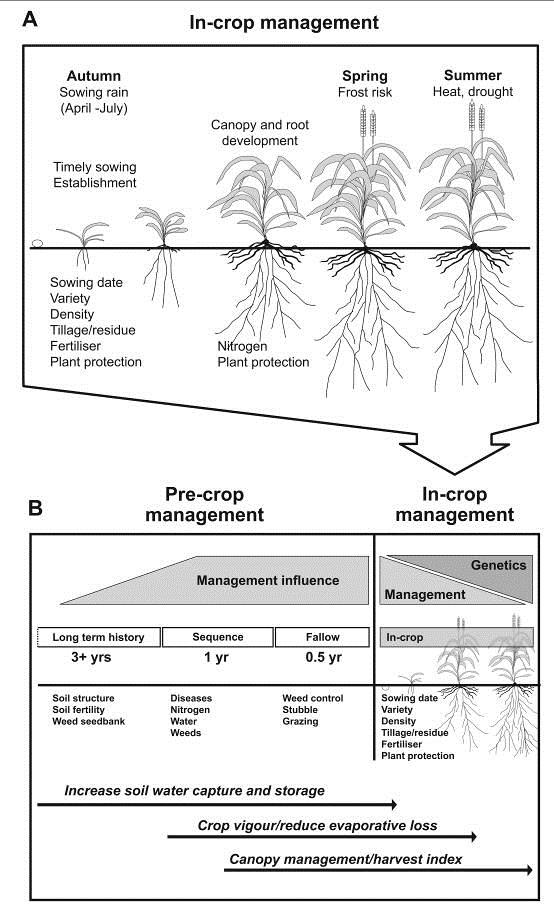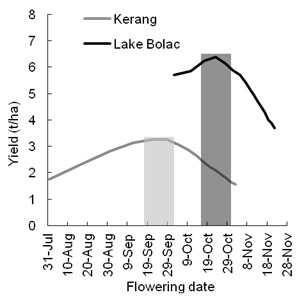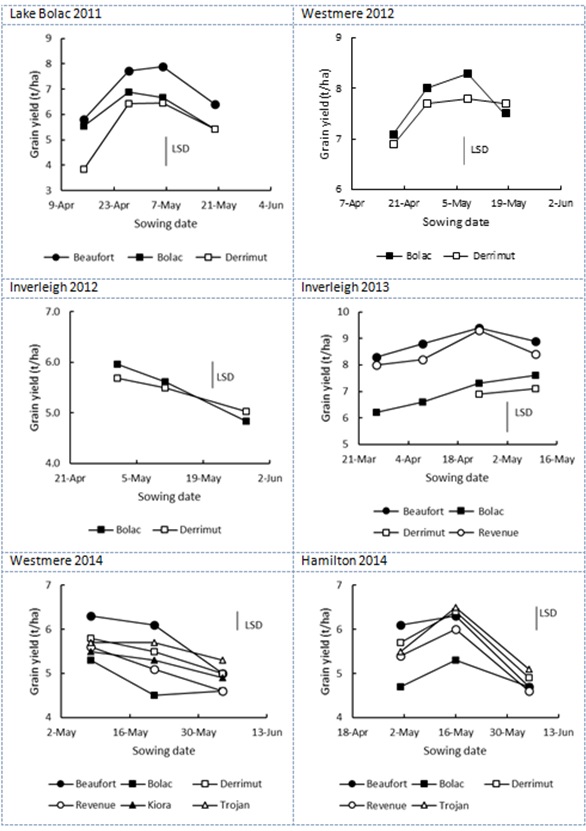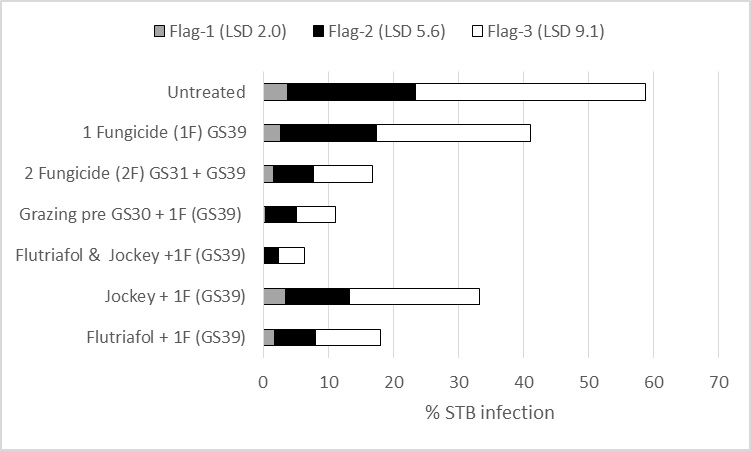Mud, weeds, frost, sheep and disease - managing the risks of early-sown wheat in South West Victoria
Mud, weeds, frost, sheep and disease - managing the risks of early-sown wheat in South West Victoria
Author: James Hunt, Tony Swan, Brad Rheinheimer, Laura Goward, John Kirkegaard (CSIRO Agriculture), Nick Poole, Tracey Wylie (FAR Australia), Gina Kreecl, Annieka Paridaen, Paul Breust and Jon Midwood (Southern Farming Systems) | Date: 27 Aug 2015
Take home messages
- Sowing wheat from late-April to mid-May is essential in order to achieve the high yields on offer in SW Victoria.
- Early sowing needs to fit into a management system that balances risks of frost, weeds, waterlogging and disease.
Background
Early wheat sowing is essential in order to achieve the high yields on offer in South West Victoria. But, sowing early in the high rainfall zone (HRZ) is not without challenges. In order to be successful, early sowing needs to fit into a farm management system designed to manage trade-offs with weed control, frost risk, waterlogging and disease.
Many of the management decisions that affect crop yields in rainfed cropping systems are made months or years before a crop is planted (Figure 1). The management factors that most contribute to yield and interact with sowing time and cultivar choice are:
- Seeding system.
- Crop rotation.
- Summer fallow management.
- Time of sowing and cultivar selection.
- Dual purpose grazing.
- Foliar disease management.
- N management.
Each one of these factors form part of a package that allows early sowing to deliver high yields in the HRZ. In this paper we go step-by-step through the important considerations within each of these factors. These considerations have been learned from four years of GRDC-funded early sowing research in SW Victoria.

Figure 1: The range of in-crop management options (A) that influence the yield of wheat crops. Critical in-crop seasonal influences at sowing, anthesis and maturity are shown. In-crop management effects are placed in the context of various pre-crop management options (B). The continuum of overlapping influences of these various options on components of water-limited yield is shown by horizontal arrows. Note that in SW Victoria too much water capture and storage can lead to waterlogging in winter.
Seeding & stubble retention system
One big advantage of no-till seeding systems is that they better allow timely sowing and establishment. This is particularly true of systems with high break-out pressure tines, knife points and press wheels.
These systems have the ability to sow directly into undisturbed soil which helps with timely establishment by removing the need to cultivate before seeding. This frees up more time after rain events to get organised for timely sowing. Cultivation also dries out the seed bed, and in marginal conditions seeds germinate more readily in undisturbed soil. In wet conditions, undisturbed soil is easier to drive on, which is perhaps more important in the HRZ. Also, weed seeds are left on the surface in undisturbed soil where they are vulnerable to predation and direct hits from pre-emergent herbicides. Most annual ryegrass populations in SW Victoria are resistant to post-emergent herbicides registered in wheat, and good control from pre-emergent herbicides is essential. With knife points and press-wheels, pre-emergent herbicides can be incorporated by sowing and used at high rates with a good degree of safety due to physical separation of seed and herbicide-treated soil.
If soil is completely dry, crops can be direct-drilled before rainfall (dry sowing). This helps get more farm area sown on time in years with a late break.
Most tined seeding systems cannot handle the volume of cereal stubble regularly achieved in high yielding crops commonly grown in SW Victoria, and big stubbles need to be managed (e.g.: mulched or burnt) early so they do not interfere with sowing.
Crop rotation
Annual ryegrass resistant to post-emergent herbicides is the biggest impediment to timely sowing in SW Victoria. Crop and herbicide rotation is the most effective way of reducing seed bank numbers and keeping them low. Given the yield penalties associated with delayed sowing in SW Victoria, it is worthwhile keeping numbers down so crops can be sown on time without relying on knockdown herbicides for grass weed control. Crop sequences that give two consecutive years of complete seed-set control – double breaks - are the most effective and profitable way of achieving this (Table 1). Some examples of effective double break options for SW Victoria are given in Table 2.
Table 1: Mean gross margin and annual ryegrass seedbank at the conclusions of a three year (2012-2014) GRDC-funded CSIRO experiment at Eurongilly in the HRZ of South East NSW.
|
Break type |
2012 crop |
2013 crop |
Annual ryegrass seedbank March 2015 (seeds/m2) |
Mean annual 3-year gross margin |
|---|---|---|---|---|
|
Double break |
Fallow |
Canola RR |
56 |
$603 |
|
Double break |
Lupin |
Canola RR |
63 |
$790 |
|
Double break |
Canola RR |
Cereal hay |
122 |
$834 |
|
Double break |
Brown manure peas |
Canola RR |
142 |
$513 |
|
Single break |
Lupin |
Wheat (high input) |
148 |
$757 |
|
Single break |
Brown manure peas |
Wheat (high input) |
162 |
$486 |
|
Single break |
RR Canola |
Wheat (high input) |
219 |
$883 |
|
No break |
Wheat (high input) |
Wheat (high input) |
366 |
$585 |
|
Single break |
Canola TT |
Wheat (low input) |
2222 |
$800 |
|
Single break |
Canola RR |
Wheat (low input) |
2387 |
$845 |
|
No break |
Wheat (low input) |
Wheat (low input) |
3140 |
$388 |
Initial ryegrass seed bank was 1815 seeds/m². ‘High input’ wheat included pre-emergent Sakura® & Avadex® Xtra, post-emergent Boxer Gold® & Axial® and high plant density (150 plants/m²). ‘Low input’ wheat included pre-emergent trifluralin & diuron and post-emergent chlorsulfuron and low plant density (75 plants/m²). All treatments were planted to wheat in 2014 which received pre-emergent Sakura® & Avadex® Xtra.
Table 2: Double break options for SW Victoria that are effective at reducing seed banks of annual ryegrass to allow early/dry sowing.
| Year 1 | Year 2 | |
|---|---|---|
| Option | Faba beans (ideally crop-topped and narrow windrows burnt) | Canola (RR or RT hybrids particularly effective, ideally narrow windrows burnt) |
| Legume-based pasture (winter cleaned and spray topped, fallowed and/or cut for hay prior to annual ryegrass seed set in spring) | Cereal hay or silage (cut and sprayed prior to annual ryegrass seed set) | |
| Cereal hay or silage (cut and sprayed prior to annual ryegrass seed set) | - |
Summer fallow management
Summer fallow rain has not historically been valued for crop production in SW Victoria, which regularly experiences winter water logging. However, its importance may increase in the future. Autumn rainfall decline over the past 17 years and improved agronomy leading to higher yielding crops have meant that crop yields in SW Victoria are increasingly water limited rather than water logged. It is currently debated whether summer weed control is worthwhile in SW Victoria from a water conservation perspective, or may in fact exacerbate waterlogging in wet winters. However, In SW Victoria nitrogen availability is critical to high yields. The GRDC Water Use Efficiency (WUE) Initiative demonstrated that for every one millimetre of water used by summer weeds, they also remove around 1.5 kg/ha N. Experiments in the medium rainfall zone (MRZ) of Southern New South Wales conducted by NSW DPI as part of the WUE initiative showed yield responses to summer fallow weed control even in very wet seasons such as in 2010, primarily due to additional N availability where weeds were controlled.
Early sown wheat crops are more vulnerable to a range of diseases that can be hosted by weeds and volunteers growing on summer fallows such as barley yellow dwarf virus (BYDV), take-all, Rhizoctonia, wheat streak mosaic virus (WSMV). Keeping summer fallows weed free reduces the risk of these pathogens attacking early sown crops.
Time of sowing and cultivar selection
Flowering time is one of the main drivers of wheat yield in environments such as SW Victoria that have cool wet winters and hot dry summers. When selecting a cultivar and sowing time combination, the intention is to match plant development with seasonal pattern and, most importantly, to get the crop to flower during the optimal period for yield. In SW Victoria the optimal flowering period is mid-to-late October (Figure 2). This period is a trade-off between declining frost risk versus increasing drought and heat risk. There is no perfect time to flower where these risks are nil, only an optimal time where they are both minimised and yields on the balance of probabilities are maximised. Figure 2 demonstrates that in SW Victoria there is actually a greater penalty for flowering too late rather than too early. The relative lateness of the flowering period in SW Victoria means that damaging frosts occur reasonably infrequently, and that dry conditions and hot north winds in October/November are historically more damaging.

Figure 2: The relationship between flowering time and yield at Kerang in the traditional wheat belt and Lake Bolac in SW Victoria. Optimal flowering periods are highlighted by light and dark grey boxes. Curves are derived from APSIM from 120 years of climate and with a yield reduction for frost and extreme heat events. Optimal flowering periods are mid-September at Kerang, and late-October at Lake Bolac.
For a given flowering time, slow-maturing cultivars sown early, yield more than faster cultivars sown later. This is because the longer growing season available to early-sown crops allows them to produce more biomass. However, in SW Victoria disease pressure from Zymoseptoria tritici limits how early it is possible to sow without suffering a yield penalty.
Four years of GRDC-funded trials in SW Victoria by Southern Farming Systems (SFS), Foundation for Arable Research (FAR) Australia and CSIRO have repeatedly shown that highest yields come from crops sown in late-April to mid-May, and from cultivars that best suit a given sowing time (Figure 3).
At the start of this period, winter wheats (e.g. Revenue, Manning, Adagio) and slow-maturing spring wheats (e.g. Bolac, Beaufort and Kiora) have delivered the highest yields. At the end of the period mid-maturing spring wheats such as Derrimut and Trojan have delivered the best results (Figure 3).
Figure 3: Grain yields for different time of sowing x cultivar experiments conducted by SFS, FAR Australia and CSIRO across SW Victoria from 2011-2014. Only yields for consistently high-yielding cultivars in those experiments are shown.
Winter wheat cultivars such as Revenue, Manning and Adagio can be sown much earlier than late April as they need to experience a winter before they will flower. Whilst no trial in SW Victoria has demonstrated a grain yield benefit from sowing these any earlier than late April, winter wheats are highly suited to grazing in the vegetative stage. The earlier they are sown the more forage they produce.
Growers wanting to graze wheat crops may benefit from sowing these cultivars very early. Some growers have successfully experimented with sowing winter wheats in spring, grazing them over summer and autumn before harvesting for grain the following summer! Sowing very early can also help reduce the likelihood of water logging in areas of paddocks prone to it.
Experiments have also looked at reducing plant density in early-sown wheat to manage lodging and improve harvest index. Results have conclusively shown that highest yields come from standard HRZ seeding rates around 200 plants/m² which are also far more effective at competing with weeds.
Dual-purpose grazing
The long vegetative period of early-sown winter wheat provides an excellent opportunity to graze with minimal yield penalty in the 'safe' grazing period. This extends from the time plants are well anchored with adequate biomass, and pesticide withholding periods have expired (around early June for early April sown winter wheat) until GS30 (around mid July for early April sown winter wheat).
Experiments and modelling suggests that 1,500-3,000 dry sheep equivalent (DSE) -grazing days/ha can be achieved during this period with little impact on yields up to 5 t/ha when crops are locked up at GS30. Higher target yields will require earlier lock-up and/or more residual biomass to achieve higher target yield. For example, 0.5 t/ha residual at the end of July is sufficient to support a 5 t/ha crop, but more residual biomass (>2.5 t/ha) will be needed on July 31 to support an 8 t/ha crop. Crops intended for grazing should be established at least 200 plants/m2 and with at least 100kg N/ha available (soil mineral N + fertiliser) to maximise early forage production. Some yield loss can be compensated for by the grazing value of the crops, especially where animals are fattened or finished on crops to make sale weights. Grazing can also be used to control large canopies, manage early leaf disease or slow crops that may be advanced in development. Grazing should be avoided in very wet paddocks where excessive soil damage is likely, especially with cattle.
Disease management
Sowing early in SW Victoria exposes crops to high pressure from Zymoseptoria tritici which needs to be managed via cultural and chemical control measures. If not yields will be reduced by disease. Time-of-sowing trials have demonstrated that disease pressure begins to reduce after late April, and delaying sowing until after then is an important cultural control. It is also important to recognise that using more resistant cultivars (such as Manning and Adagio) for early sowing is a key consideration in minimising fungicide usage. This is particularly important considering the recent discovery of Z. tritici strains with low-level resistance to triazole fungicides. In susceptible cultivars, such as Revenue, two fungicide applications are required for successful control of Z. tritici. The first can either be a high rate of flutriafol (200g/ha active ingredient) applied in-furrow, or a foliar fungicide at GS31. Both of these options have been shown to be equally effective (Figure 4).
Two trials have demonstrated that defoliation at Z30 is as effective as either of these fungicide applications, and hard grazing is another cultural control option to growers who are happy to graze crops (Figure 4). The second application of foliar fungicide for Z. tritici control must be applied to the flag leaf (GS39).

Figure 4: Influence of early applications of seed treatment, in-furrow flutriafol, grazing and GS31 fungicide on Zymoseptoria tritici control in early sown wheat (April 11) – cv Revenue, Inverleigh, Victoria 2014. Notes: Flutriafol in furrow applied at high rate (200g ai/ha).
Foliar Fungicide applied at GS31 & GS39 was Prosaro® 300ml/ha (NB this product whilst approved for use in wheat does not have a registration for control of Z. tritici)
Jockey® Stayer® applied at 450ml/100kg seed
Several wheat cultivars suited for early sowing (e.g. Beaufort) are very susceptible to stem rust, and these cultivars should be protected by applying foliar fungicides at head emergence.
Barley Yellow Dwarf Virus (BYDV) sporadically infects early-sown crops and needs to be managed, particularly in crops sown before May. The winter wheats Manning and MacKellar carry host-plant resistance to BYDV and are highly suited to very early sowing and grazing. Cultivars such as Revenue that do not carry BYDV resistance need to be protected by from infection by aphid vectors with insecticides.
An effective insecticide program should start with a seed dressing product registered for aphid control (e.g. imidacloprid). It needs to be backed up with a foliar insecticide (e.g. lambda-cyhalothrin) at GS13 (three leaves emerged) if aphids persist after that If planning on grazing, check stock withholding periods on any insecticides used.
N management
High-yield potential of early-sown crops in SW Victoria needs to be supported with N. Dryland wheat crops need to see around 40 kg/ha mineral N per tonne of grain yield at 11 per cent protein. A 6t/ha crop at 11 per cent protein needs a total N supply of 240kg/ha N. Some N is available in the soil at the start of the season and some will mineralise during the growing season. The remainder needs to be supplied as fertiliser. The amount available can be determined from soil cores (deep N) either before sowing or, in very wet winters, in spring after N denitrification and leaching. Mineralisation is very hard to predict and dependent on a lot of variables (organic carbon content of soil, moisture, temperature, surface residue). It can range from greater than 80 kg N/ha following a legume pasture in years with good spring rainfall, to 0 kg/ha following a cereal crop with a large stubble load in a dry spring.
In early-sown crops most N should be top-dressed to avoid excessive early growth and lodging. A split that has been successful in early sowing trials is 25 per cent of total N budget applied mid-tillering, 50 per cent at GS31 and the remaining 25 per cent GS37.
Conclusions
Four years of trials have demonstrated that early sowing (late-April to mid-May) is essential in order to achieve the high yields on offer in SW Victoria, but this practice needs to fit into a farming system that manages risk of frost, weeds and disease. Some important general aspects which should be considered in such a system have been outlined above, which can easily be developed and adapted to suit individual farming systems, styles and preferences.
Contact details
James Hunt
GPO Box 1600
Canberra ACT 2601
0428 636 391
james.hunt@csiro.au
@agronomeiste
